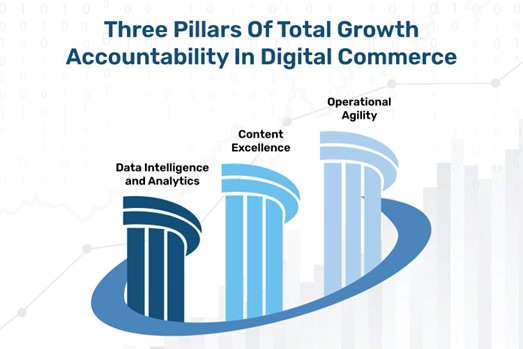In today’s fast-paced and ever-evolving digital landscape, businesses constantly seek new strategies to achieve sustainable growth. The rapid advancements in technology, coupled with the shifting preferences of consumers, have created a dynamic and highly competitive environment for digital commerce. In such a landscape, a holistic approach to growth is crucial to stay ahead of the curve. This is where Total Growth Accountability comes into play, offering businesses an inclusive framework to navigate the new realities of digital commerce and drive overall business growth.
Table of Contents
What is Total Growth Accountability?
Total Growth Accountability encompasses a mindset beyond mere revenue generation and focuses on the broader spectrum of growth opportunities available to businesses in the digital era. It entails a comprehensive assessment and management of key performance indicators (KPIs) impacting overall business growth, from customer acquisition, retention, operational efficiency, and innovation. By adopting a holistic approach, businesses can effectively align their strategies, resources, and teams to maximize growth potential in all facets of their digital operation.
Importance Of Total Growth Accountability In The Realm Of Digital Commerce
Total growth accountability requires brands to take ownership and responsibility for their entire digital shelf. This includes aspects such as product content, search visibility, pricing strategy, and brand positioning. By embracing total growth accountability, brands can maximize growth opportunities and establish a solid competitive advantage. This empowers them to make data-driven decisions, identify areas of opportunity, and optimize resources to drive business growth. It encourages cross-functional collaboration and breaks down barriers that often hinder innovation and growth.
Total Growth Accountability also enables organizations to proactively adapt to emerging trends, consumer preferences, and technological advancements, ensuring they remain agile and responsive in an ever-changing digital landscape.
We will discuss strategies for fostering a culture of accountability within organizations, pillars, and examples to better understand the shift to this.
What Are The Three Pillars Of Total Growth Accountability In Digital Commerce?

- Data Intelligence and Analytics
Leveraging data-driven insights is crucial in today’s digital commerce landscape, where understanding consumer behavior, market trends, and competitor strategies is paramount. Brands should embrace advanced analytics tools to extract meaningful information from vast data sets, empowering them to uncover untapped growth opportunities and optimize their performance on e-commerce platforms.
- Content Excellence
Crafting compelling and accurate product content is essential for success in e-commerce marketplaces. Brands must optimize their content for search visibility and ensure consistency across all touchpoints. This includes creating informative product titles, detailed descriptions, and relevant attributes. By providing high-quality content, brands can improve discoverability and enhance the overall shopping experience for consumers.
- Operational Agility
Operational agility is crucial in adapting quickly to market dynamics and capitalizing on emerging trends. Brands should embrace agile processes and collaborate closely with supply chain partners to ensure seamless inventory management and fulfillment. Also, can leverage tools that predict stock trends, offer OOS alerts to deliver exceptional customer experiences, and optimize operations.
Strategies For Total Growth Accountability In The Age Of Digital Commerce
Implementing effective strategies is essential for achieving total growth accountability on e-commerce marketplaces. Here are some key strategies to consider:
- Advanced Product Visibility Strategies
These strategies include optimizing product content with relevant keywords, conducting thorough keyword research, leveraging customer reviews and ratings, utilizing rich media content such as high-quality images and videos, and leveraging social media and influencer marketing. By implementing these strategies, brands can enhance their online visibility, attract more potential customers, and drive overall growth in the digital commerce landscape.
Take AI leverage to finetune further your organic efforts- Data analysis allows you to efficiently examine all available information to identify areas where you may be lacking. It helps you determine if your product titles lack relevant keywords if your images are optimized for mobile devices, and if your product feed contains all necessary content. Regular content audits are crucial for promptly identifying and rectifying product display page content deficiencies. By generating scorecards, you can assess the accuracy and completeness of your product information, enhance discoverability and purchase potential, and pinpoint areas that require improvement.
- MAP Monitoring (Minimum Advertised Price)
Maintaining consistent pricing across multiple channels/platforms is essential; it involves setting a minimum advertised price to ensure fair competition and protect brand value. Here are key steps to implement this strategy effectively:
- Establish a MAP policy: Clearly define your minimum advertised price policy and communicate it to all authorized retailers.
- Monitor compliance: Regularly monitor pricing across various channels to identify violations and take appropriate action.
- Enforce consequences: Ensure that violators face the consequences, such as warnings, account suspensions, or termination of partnerships.
Example: A high-end fashion brand implements MAP monitoring by tracking online marketplaces and authorized retailers to prevent undercutting. By maintaining consistent pricing, they uphold their brand’s exclusivity and avoid price wars that can erode their margins.
Read more on how Paxcom’s digital shelf analytics tool, Kinator, can help track MAP violations.
3. Product Portfolio Management
Managing a product portfolio involves optimizing the product range and continually assessing its performance. Here’s how to implement effective portfolio management:
- Analyze product performance: Regularly review sales data, customer feedback, and market trends to identify top-performing and underperforming products.
- Optimize product mix: consider investing in marketing efforts, inventory management, and supply chain optimization for these products. Simultaneously, assess the underperforming products and evaluate their potential for improvement.
- Expand or diversify: Identify opportunities for product line extensions, new market segments, or partnerships to enhance the brand’s offerings.
Example: An electronics category brand regularly reviews sales data and identifies a decline in demand for a particular smartphone brand. They allocate resources toward promoting a different brand with higher customer satisfaction and market demand, resulting in increased sales and improved profitability.
4. Centralized Decision Making
Centralized decision-making allows for a cohesive strategy across departments and enables faster execution.
- Establish a centralized authority: Designate a decision-making body or individual responsible for aligning goals, coordinating strategies, and resolving conflicts.
- Foster cross-functional collaboration: Encourage open communication and collaboration among different departments to consider all perspectives. By breaking down silos and promoting cross-functional teamwork, diverse perspectives can be leveraged, leading to better decision-making and accountability for overall growth.
- Measure by share of voice and sales on important channels to compare against competitors’ performance. Understand how your brand is performing regarding visibility and sales on key channels relative to your competitors. This information can help identify areas for improvement and guide resource allocation to maximize impact.
- Implement a decision-making framework: Develop a clear decision-making framework that includes key performance indicators (KPIs) and metrics to measure growth accountability. Define criteria such as revenue impact, customer satisfaction, market share growth, and return on investment (ROI). This framework ensures that data-driven decisions align with the organization’s growth goals.
Example: A global online marketplace centralizes decision-making by creating a dedicated team responsible for coordinating marketing campaigns, product launches, and customer service initiatives across different regions. This approach ensures consistent branding, efficient resource allocation, and faster market responsiveness.
4. Resource Allocation Fluidity
Budget fluidity involves reallocating funds strategically based on performance and changing priorities. Implement this strategy using the following steps:
- Establish performance metrics: Define key performance indicators (KPIs) for each marketing initiative, product line, or sales channel.
- Continually evaluate performance: Regularly assess the performance of different initiatives or campaigns to identify high-performing and underperforming areas.
- Flexible budget allocation: Allocate resources based on the performance evaluation, shifting funds from underperforming areas to those with higher returns.
Example: A consumer electronics brand selling on a popular online marketplace analyzes its advertising campaigns and identifies that its sponsored product ads consistently generate higher click-through rates and conversions than banner ads. Recognizing this trend, they reallocated their budget by increasing investment in sponsored product ads and reducing spending on banner ads. This strategic shift allows them to maximize their visibility within the marketplace, improve product discoverability, and ultimately drive higher sales and revenue from the optimized ad strategy.
Final Thoughts
As we conclude our exploration of total growth accountability, it is evident that embracing this approach is vital for brands to thrive in the dynamic digital commerce landscape. By adopting proactive pricing strategies, optimizing the product portfolio, integrating marketing and sales efforts, and maintaining operational agility, brands can navigate the new realities of digital commerce and position themselves for success.
Paxcom offers a range of services tailored to the unique needs of brands. From data intelligence and analytics to content excellence and operational agility, Paxcom has the expertise to help brands optimize their digital shelf presence and drive growth.
Total growth accountability is not just a concept but a strategic imperative for brands operating in the e-commerce marketplace. Embrace the new realities of digital commerce, unlock growth opportunities, and thrive in an increasingly competitive landscape.
Contact us at info@paxcom.net for more, or see our tool in action here.














